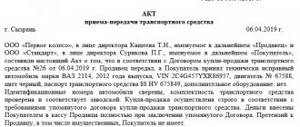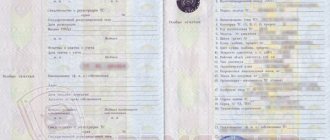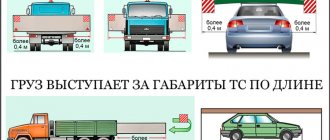Document year: 2019
Document group: Acts
Type of document: Acts
Download formats: DOC, PDF
Automobile acts confirm that one person transferred a vehicle to another, provided services or necessary work on the vehicle. Similar documents are drawn up for any moving vehicle: from a moped to a truck. The parties involved can be different categories of persons; the act is drawn up between legal entities and between private individuals. Also, documentation of the transfer of a car can be drawn up if one participant is an individual, and the second is a legal entity.
Such acts are drawn up in different life situations: from sale to transfer of a car for repair or service. Papers are also drawn up to inspect the technical condition of the machine. Such documents are needed after transport accidents, for issuing insurance policies, and for inspection by the traffic police.
We will analyze in detail the different types of acts, consider what is written in such documents, as well as their samples.
Car acceptance certificate
Acceptance and transfer of a vehicle can be carried out upon a change of owner (during sale under a purchase agreement), upon a change of owner (under a rental agreement, leasing), for transfer of the vehicle to a car service center.
Legal relations can be between legal entities and individuals, or in mixed agreements. These are cases when one person is a legal entity and the other is a private person. Such situations are the most common: a legal entity - a car service center, a car dealership or an official dealer. For individuals, legal relations mainly relate to the purchase and sale of used cars.
The most common case is a change of owner under a purchase and sale agreement. It is believed that the acceptance certificate is an optional document when conducting such transactions. However, without it, it is impossible to terminate the contract through legal proceedings. This is especially true in cases where the document does not include clauses regarding the acceptance and transfer of the vehicle.
Thus, the fact of a change of owner can be confirmed in two ways:
- describe this in detail according to the text of the contract;
- draw up an act of acceptance and transfer of funds.
In this case, the last point is the most desirable. The act will become an annex to the contract; it must describe in detail the technical characteristics of the vehicle, interior decoration, obvious defects and breakdowns, as well as agreement that the receiving party has no claims against the transferring party. And this fact is confirmed by the signatures of the participants.
The paper is compiled according to the number of sides. Usually two versions are printed. You can do it for free, which will be standard when transferring a vehicle from one driver to another (with or without transfer of ownership).
The same paper can be drawn up if property is transferred under a gift agreement. The fact is that with this document various written agreements take on legal force and can only be broken through legal proceedings. For example, if the buyer believes that the seller has violated his rights as a consumer.
Let's consider special cases of drawing up acts.
Certificate of acceptance of the car to the car service center
The transfer of the vehicle for repair and maintenance must be confirmed by a transfer deed. Most service stations neglect this. However, in the future, if claims arise, oral agreements will not be valid, and it will be impossible to challenge your position in court, referring to them.
Any major service will issue an acceptance certificate for repairs and maintenance without reservations.
The document specifies standard settings:
- information about the paper (date and place of signing, which agreement is attached);
- brief description of technical characteristics;
- description of completeness, operability and appearance (a schematic drawing is used);
- the estimated completion time of the work is indicated;
- Additional comments are given, spare parts are indicated that the client sends for repair (if sent).
The document is endorsed by the parties.
There is no single paper sample, so each service station uses its own template, but the information described above is common to most stations.
Act to the lease agreement
Temporary use of the car is fixed in the rental agreement, and the actual transfer and further return is prescribed in the transfer deed and the return deed.
Each landlord uses their own rental template. Usually these are generally accepted norms when transferring a vehicle: an indication of which contract is being transferred, when and where the appraisal report was drawn up, details about the rented car (technical characteristics, defects, inventory of internal components, malfunctions).
Renting a car is risky for both parties: the lessor can protect himself in case of possible damage, the renter can protect himself when returning the car, so that the owner does not blame him for damage that he did not cause.
Document meaning
This act refers to the primary documentation and is the most important accounting document. Moreover, it is not independent, but serves as an annex to any agreement: purchase and sale, service maintenance, rent, leasing, etc.
Some car owners do not understand the role of the deed (which is indeed very significant), believing that signing a contract is enough to complete the transaction. This is a fundamentally erroneous opinion. The fact is that the contract itself, in fact, is only an intention to carry out any actions in relation to the car and can be terminated at any time, but the actual evidence of the transfer of the vehicle from one person to another is the corresponding acceptance certificate -transmissions. After it is signed, it will no longer be so easy to challenge or terminate the contract, and only in court.
In addition to the above, we must not forget that on the basis of this act, the vehicle is written off from the balance sheet of one organization and accepted for accounting in another.
Summarizing what has been said, let's summarize: from a legal point of view, the document is confirmation that the car has been transferred from the former owner to the new owner (i.e., in the absence of this act, the transfer may be considered invalid). If there are unfounded claims or disagreements under the contract, this document can become part of the evidence base, both for one party to the contractual relationship and for the other.
Vehicle inspection report from the traffic police
The inspection report is used by the State Traffic Inspectorate to register the vehicle. Often the procedure is carried out when there is a change of owner in various legal relationships: donation, purchase, etc.
To do this, the vehicle is first inspected by a traffic police officer and a specialized technician. The inspection form records:
- identification data (make, VIN, engine code, etc.);
- brief description (color, year of manufacture);
- date and location of inspection;
- the text of the act describes in detail the condition of the car: defects, malfunctions, breakdowns, possible breakdowns in the future, the general condition of the car outside and inside, the causes of malfunctions.
At the end, the persons who were present during the inspection are listed and they endorse the document.
Certificate of inspection of the technical condition of the car
After inspecting and assessing the technical condition of the machine, the result of this procedure is the drawing up of a report. The document describes in detail: the condition of the body, bumper, tires, headlights, gearbox and other elements of the car. Present and future car malfunctions are described.
Drawing up such an act can be:
- one-time, for example, after a traffic accident;
- periodic. For example, in companies that carry out passenger and cargo transportation, vehicle fleet diagnostics are carried out, and according to the report, the vehicles are allowed to travel.
However, the frequency may vary, depending on the specifics of the organization.
In addition to a detailed description and assessment of the condition of the car, the report specifies its characteristics, information from the vehicle’s passport, and information about technical inspection.
Inspection report after an accident
Drawing up an inspection report after an accident is one of the common cases of such document flow. The report assesses the extent of damage and calculates the damage caused. The calculated amounts are used by the insurance company to pay the owner's insurance.
Like all automobile acts, the inspection document after an accident is drawn up in free form, but it is important for the insurance company that the appraiser writes down the following points:
- document details;
- information about the parties involved in the inspection, the owner of the car;
- information about the vehicle itself;
- car damage (details);
- actual condition of the vehicle.
Attached to the paper are photographs and a diagram of the car with designations and the degree of damage (significant, minor and places where impacts occurred during a collision).
The vehicle damage report is signed by the appraiser, the owner of the vehicle and witnesses (if any were present during the procedure).
Vehicle defect report
The defect report is both a measure for assessing the need to repair a particular element of the vehicle, as well as a basis for writing off components and parts.
Defects in the engine, gearbox, wheels and other elements of the car are described in detail.
The defective act does not have a single form; the organization can draw it up on a simple sheet of paper or on a letterhead with a company designation.
Often, a defect report is drawn up in the form of a table that lists the detected defects, the possibility or impossibility of repair (replacement), and the reasons for the impossibility of eliminating defects.
The assessment is given by a specially created commission, each member of which signs the document.
In a company's accounting, such paper refers to primary reporting; parts, spare parts or fixed assets are written off entirely. The act is the basis for the need for repairs, and its cost is calculated based on it.
What to look for when handing over a vehicle to a driver
In organizations that practice assigning a particular vehicle to a driver, there is usually a clear procedure for the acceptance and transfer of a vehicle from one responsible person to another. It takes into account all stages of this procedure, starting from the creation of an appropriate order by the head of the enterprise, including inspection of the machine, written recording of its condition and ending with the formation of a special act.
It should be noted that in companies that have properly organized the procedure for assigning a car to drivers, before handing over the vehicle to any employee, they undergo detailed introductory and initial training.
Moreover, the driver is required to undergo an internship, and only after that he will be entrusted with a separate car.
Certificate of completed car repair work
This document is used to provide actual proof of the repair work carried out. In the accounting of a car repair shop and service station, the act is the basis for writing off spare parts used during repairs.
The report is signed between the workshop and the owner of the vehicle; it describes in detail what work was carried out on the vehicle, what spare parts were installed, what defects and malfunctions were eliminated.
When compiling the STO, it relies on its own developed sample or advisory KS-2. Despite the drawn up form, the paper must stipulate:
- the name of the legal entity that carried out the work, its details;
- information about a private person, if the repair was carried out in a private workshop;
- deadlines for completing the work, their detailed description;
- prices for work;
- original signatures of the parties;
- act of installing spare parts on a car.
The certificate is a confirmation of high-quality and complete car repairs.
When is the vehicle transfer deed concluded?
In any situation where property is transferred from one person to another for permanent or temporary use, it is recommended to draw up a transfer deed. These are cases when:
- a purchase and sale agreement is concluded and ownership passes to the buyer;
- a lease agreement is concluded under which the lessee has the right to dispose of the car for a set fee for a certain period;
- the rental period of the property expires (or the contract is terminated early) and it is returned to the lessor.
The act of measuring the fuel consumption of a car
To constantly monitor fuel consumption by vehicles, the organization draws up a report on control measurements of fuel consumption rates. Next, it is used as a guide; in this act, the maximum consumption rate in the described situation is prescribed for a certain brand of car.
To carry out the measurements, a commission is assembled, often consisting of an economist, a mechanical engineer and a driver assigned to the vehicle.
The act states:
- header with the title of the document;
- in the upper right corner - approval of the act by the manager (signature, transcript and date);
- the text indicates the composition of the commission, the make of the car, its mileage, and the type of fuel used;
- the mileage traveled, the fill level of the tank at the beginning and end of the procedure are indicated, the same is prescribed with the speedometer indicators;
- if fuel was refueled or drained, this is indicated in the main part;
- The final fuel consumption is calculated, consumption per 100 km in liters.
If a cargo or service vehicle is used both in the city and outside the city, two reports are drawn up, because in different cases there will be different fuel consumption.
In the future, the driver, engineer and accountant, leading the fleet rely on the drawn up control measurement reports.
Transfer and acceptance certificate - download a simple sample (form) 2021 + how to draw up
What is an act of acceptance of transfer
The act of acceptance and transfer of goods is an important document in economic relations. It is necessary to compare the goods received or services provided and the actions actually performed.
The acceptance and transfer certificate confirms the integrity of the goods, its redemption value and other important characteristics specific to this particular product (serial number, brand, etc.).
There is no statutory template for this document. It all depends on the individual characteristics of the goods being transferred and the transaction being concluded. Despite this, the law establishes the minimum characteristics that must be on the form:
- Subject of the transaction (name);
- Product characteristics: article number, brand, etc.;
- The responsible or authorized person transferring the goods and receiving them;
- Name of the organization transferring the goods;
- Date of preparation and signing of the Act;
- Signatures and seals of the parties;
- Reference to the agreement in accordance with which this Act was drawn up (for example,);
- Information regarding claims regarding the quality of the transferred product;
- Cost according to the contract;
- Number of acts.
You should not automatically sign the acceptance certificate without first checking the quality of the goods. By signing the act, you agree that you have no claims and everything that happens in the future with the product is entirely your responsibility.
How to draw up a transfer and acceptance certificate
The form is drawn up in two copies.
If one of the parties is an individual, then it is important to indicate all his passport details and places of registration.
Acceptance and transfer certificates are drawn up both for individual goods and for a group of goods. In the latter case, it is important that there is relevant information in the act of completing the transferred cargo.
If desired or necessary, the actual place of transfer of the cargo is specified in the act.
The absence of an Act limits the rights of the parties regarding claims against each other in the future. That's why it's important to have this document in hand.
The act of assigning a vehicle to the driver
Such acts relate to intra-organizational document flow. The template and form are developed by an authorized employee of the company. The act states that the car is assigned to a specific driver, who is responsible for the condition of the car. This is typical for securing a truck and company vehicle.
Why are the funds assigned: so that in the event of malfunctions, accidents, breakdowns, etc., the assigned employee bears responsibility for the vehicle. In this case, he either repairs it himself or compensates for the damage caused.
The fastening procedure is as follows:
- drawing up an order from management to assign the car to a driver (or several);
- Carrying out a thorough inspection of the machine;
- documenting the inspection results;
- drawing up an act;
- conducting briefings with the person in charge.
The completed deed of transfer specifies the basis for its preparation (order of the manager), date and place. The text records the results of the inspection and provides information about the assigned person. At the end, the document is signed by the participants of the procedure. The paper is prepared in written or printed form.
If the driver assigned to the car is absent and the vehicle is temporarily transferred to another employee of the company, a transfer act is drawn up. It must specify the technical characteristics and condition of the vehicle at the time of transfer.
How to correctly fill out the vehicle acceptance certificate?
It is recommended to include the following details in the car acceptance certificate to the driver:
- full name of the organization that owns the vehicle (company letterhead may be used);
- document's name;
- date and place of compilation;
- positions and full names of all members of the commission created to transfer the car to the driver, as well as details of the order on the basis of which the commission was created;
- information about the driver (structural unit, full name, driver’s license details, date and number of the order or power of attorney to drive the vehicle);
- information about the car indicating its model, technical characteristics, condition, mileage as of the date of transfer, etc. in as much detail as possible in accordance with the PTS and actual availability;
- complete set and special equipment that is transferred along with the vehicle (tools, first aid kit, fire extinguisher, etc.);
- presence and quantity of fuel in the tank;
- signatures of all members of the transfer commission and the driver.
Act on the provision of transport services
The signing of an act on the performance of transport services is the final stage in the agreement for the provision of services. This document is used by logistics companies and carriers in relation to their clients. A paper is drawn up for those who performed transport services. At the same time, their type is not important; it can be passenger transportation or cargo transportation. The type of transport is also not important.
The act is evidence of the execution of work under the contract for the provision of transport services and is an appendix to it. However, only with its preparation is it possible to break the terms of the contract through the court and prove violations of your rights.
The act is drawn up in any form: free or established by an organization. Frequently, cargo transportation and passenger flight companies create their own uniform templates.
The act specifies:
- the basis for its preparation (to which agreement);
- volume of services provided, their prices;
- a record is made that the work has been completed in full and the parties have no mutual claims;
- information about the final payment is recorded;
- the documents attached to the act (waybills and others) are indicated.
The provision of services is certified by the signatures of the parties.
Vehicle check
The main purpose of the transfer acceptance certificate is to certify the fact of transfer of the car from one counterparty to another. They can be citizens of the Russian Federation, foreigners, stateless persons, as well as legal entities. At the same time, the document indicates that the car was transferred to the purchaser, the lessee, in proper technical condition.
Before drawing up the certificate, experts recommend thoroughly checking the car , which, first of all, is in the interests of the purchaser of the vehicle. If shortcomings and malfunctions in the car are identified, then this should definitely be indicated in the report - in order to make it easier to challenge your rights in court.
If the car is not checked in a timely manner, the buyer or lessee will have to prove that he did not know and should not be aware of the defects (for example, when they are hidden and cannot be identified immediately - the engine eats oil, defects in the electronics that appear only after a long drive, etc. .d.).











